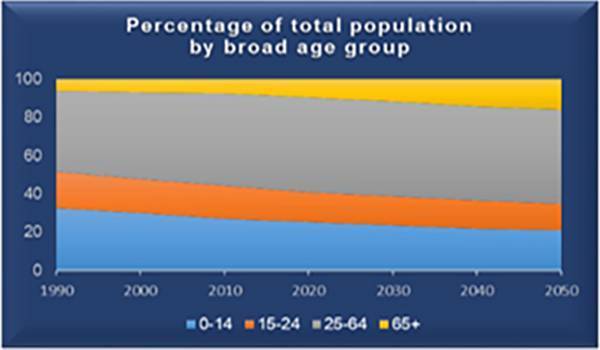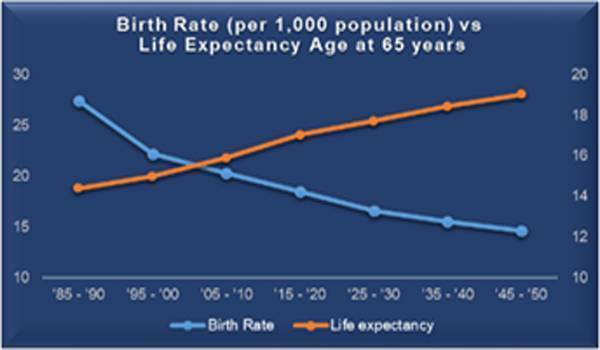 Another megatrend of human race is Urbanization where small city become mega city, small town become city. Urbanization is good for the economy since overall economy is being benefited through urbanization. Employment opportunity is getting increased which lead to upsurge in earnings and standard of living. There were 43% people living in urban area in 1990 which will be around 68% in 2050 as per present projection.
Another megatrend of human race is Urbanization where small city become mega city, small town become city. Urbanization is good for the economy since overall economy is being benefited through urbanization. Employment opportunity is getting increased which lead to upsurge in earnings and standard of living. There were 43% people living in urban area in 1990 which will be around 68% in 2050 as per present projection.
 Technology enhancements enrich our existing lifestyle, and it is always morphing and expanding. Every new technology has the potential to improve lives. Nevertheless, it also has the potential to negatively influence our society in some cases. The birth rate, death rate and fertility rates are less in urban areas which has a direct impact on economic growth by reducing the human resource force, which is a major factor in production. It will also continuously increase share of aged persons in the population.
Technology enhancements enrich our existing lifestyle, and it is always morphing and expanding. Every new technology has the potential to improve lives. Nevertheless, it also has the potential to negatively influence our society in some cases. The birth rate, death rate and fertility rates are less in urban areas which has a direct impact on economic growth by reducing the human resource force, which is a major factor in production. It will also continuously increase share of aged persons in the population.
 The increasing share of aged people will sink human resource market relative to the total population. Increasing urbanization and declining fertility, reduces the human resource in rural area. Although, major consumer of agriculture and farming products are from urban areas, whereas agricultural activities, farming are being performed in rural area. Declining human resources at rural area may hit our food security programme. To measure the magnitude of this issue we can consider the ratio of population aged 65 or over to per 100 population of aged 25 to 64 years. As per United Nation data, there were around 15 persons aged 65 years or over in 1990 which will be around 32 in 2050 per 100 persons aged between 25 – 64 years.
The increasing share of aged people will sink human resource market relative to the total population. Increasing urbanization and declining fertility, reduces the human resource in rural area. Although, major consumer of agriculture and farming products are from urban areas, whereas agricultural activities, farming are being performed in rural area. Declining human resources at rural area may hit our food security programme. To measure the magnitude of this issue we can consider the ratio of population aged 65 or over to per 100 population of aged 25 to 64 years. As per United Nation data, there were around 15 persons aged 65 years or over in 1990 which will be around 32 in 2050 per 100 persons aged between 25 – 64 years.
 Policymakers are taking many steps to increase the birth rate. China replaced there One child policy with a two-child limit in 2016 which has also failed to increase birth rate. China has now announced that it will allow up to three children per couple. Japan and many countries have also undertaken steps to support young couples in upbringing their children, for instance, making preschool education free to increase birth rate. It is debatable whether steps taking by policymakers will solve human resource issue.
So, we may face multi dimensioned socio-economic challenges in near future if we don’t address the same today and taking preventive action to make our world a better place to live in for every human being. There is no choice rather than taking more support of technology and machine in our day-to-day life. The United Nation’s Sustainable Development Goals (UN SDGs) were introduced in 2015. There are 17 goals included in the agenda 2030. The mobile communication sector plays an important role and it can significantly contribute to the achievement of the SDGs by offering infrastructure and access to digital services [ITU; GSMA 2018].
With 5G technology we can start to achieve these SDGs which will be further enhanced with upcoming new technology. Due to its inherent properties, 5G radio systems along with its associated network architecture can deliver heterogeneous and diverse use cases with extreme range of requirement that will transform our individual lives, economy, society as well as springboard of robotic world. Previous mobile technologies help communication within humans but 5G will enable machine to machine and machine to human communication also. 5G use cases can be broadly split into three use case categories.
Policymakers are taking many steps to increase the birth rate. China replaced there One child policy with a two-child limit in 2016 which has also failed to increase birth rate. China has now announced that it will allow up to three children per couple. Japan and many countries have also undertaken steps to support young couples in upbringing their children, for instance, making preschool education free to increase birth rate. It is debatable whether steps taking by policymakers will solve human resource issue.
So, we may face multi dimensioned socio-economic challenges in near future if we don’t address the same today and taking preventive action to make our world a better place to live in for every human being. There is no choice rather than taking more support of technology and machine in our day-to-day life. The United Nation’s Sustainable Development Goals (UN SDGs) were introduced in 2015. There are 17 goals included in the agenda 2030. The mobile communication sector plays an important role and it can significantly contribute to the achievement of the SDGs by offering infrastructure and access to digital services [ITU; GSMA 2018].
With 5G technology we can start to achieve these SDGs which will be further enhanced with upcoming new technology. Due to its inherent properties, 5G radio systems along with its associated network architecture can deliver heterogeneous and diverse use cases with extreme range of requirement that will transform our individual lives, economy, society as well as springboard of robotic world. Previous mobile technologies help communication within humans but 5G will enable machine to machine and machine to human communication also. 5G use cases can be broadly split into three use case categories.
| Automation Use cases | Description of Automation Use case | Mapping to 5G Technology capabilities |
|---|---|---|
| Autonomous Smart Factory | AI controlled robot and machines will support human resource to streamline and transform their processes and will work safely together | 5G technology with its inherent property of ultra-low latency and robust reliability will support all these use cases |
| Autonomous Assisted / Self driving Car | Autonomous self-driving car will reduce driver error which causes more than 90 percent car accident. With better efficiency, emission will be much lower which will support sustainable growth of human race | |
| Mission critical application | Mission critical application like Remote surgery, autonomous Smart Electrical Grid will enhance our day-to-day lifestyle | |
| Autonomous Smart Metering | It will facilitate accurate billing, improve our awareness of energy consumption, increase energy efficiency which in turn will save money and energy consumption | 5G technology can support connectivity with massive no of different type of sensors for different application & different performance class. |
| Autonomous Smart Farming | It allows farmers to track farm operations and performance, make better informed decisions to improve productivity, reduce waste and respond more quickly which help to save time & money. | |
| Autonomous Freight-tracking systems | It will reduce fuel costs, improved driver efficiency & productivity, route optimisation & journey planning. Providing customers with accurate shipping information and tracking updates lets them know that their business is both dependable and trustworthy | |
| Autonomous Smart Wearables | It will help us to monitor our fitness levels, track our location with GPS, and view text messages more quickly. | |
| Hotspots & Mobile Broadband | People will access data with better efficiency in compared to present scenario | Throughput capacity of 5G technology is multi-fold better than other mobile technology. It can support many new autonomous use cases which require very high throughput |
| Autonomous Smart Office | Enhanced Mobile Broadband (eMBB) will facilitate workplace where technology enables people to work better, faster and, of course, smarter way. | |
| Large Scale events | Concerts and sporting events may be served by eMBB, enabling high data rates where tens or hundreds of thousands of people are gathered | |
| Multimedia services powered by AR/VR | eMBB can provide seamless, high-definition video streaming, mobile TV and real-time content over broad coverage areas automatically based on user demand |

Conclusion: Above automated use cases powered by 5G technology endorse that automation will always increase productivity, improve efficiency, reduce human dependency in day-to-day activities and thus human errors, provide better quality, reduce waste and more efficient use of materials, reduce lead time. All sectors will undergo major paradigm shift to enable automation and it will lead to sustainable growth of human race. Let make 5G technology and robots our partner of the never-ending journey of humankind.
References:- United Nations, Department of Economic and Social Affairs, Population Division (2019). World Population Prospects 2019.
- United Nations, Department of Economic and Social Affairs, Population Division (2018). World Urbanization Prospects: The 2018 Revision, custom data acquired via website.
- Influenced by many training sessions I attended to upgrade my skillset in 5G technology













Leave a Reply
Your email address will not be published.